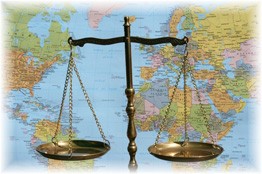In this blog post, Pramit Bhattacharya, Damodaram Sanjivayya National Law University writes about the concept of Private International Law and its unification. The post discusses the basis of having Private International Laws and in what ways the laws can be unified. The post also looks into the benefits and challenges regarding the process of unification.
The Conflict of Laws, or as it is more commonly known by the name of Private International Law is that branch of law which deals with those case where some foreign element is present; to be more precise the geographical factor is present. This situation may arise when the parties are residents of a foreign country and any dispute arises between them or there a dispute between people belonging to two different countries. And in all the cases where any foreign element is present, the Court applies the principle of “conflict of laws.’
In the present era, almost all countries have a system in place to deal with conflict of laws. This system is required for the increased movement of people from one territory to the other due to various reasons. The Courts in such cases voluntarily apply the principle of conflict of laws. While there are some laws which are accepted in most of the countries, some rules might differ depending on the place. 
Private International Law determines that what law will be applied when there is a dispute between the parties relating to their private rights and obligation, but where some foreign element is also present, and what Court shall have the jurisdiction to try the dispute. According to this, Private International Laws may possess the following principles:[1]
- It is a branch of national or local laws of the country.
- The cases under the purview of Private International Laws always involve a foreign element.
- The local Courts govern the cases.
- The law is administered over individuals.
In simple words, Private International Laws can be defined as a means to find out the way to solve a dispute when any foreign element is involved.
Basis of Private International Law
The basic principle behind applying Private International Law is to ensure that justice is done. It will be a grave injustice to the parties if cases are decided using local laws of the land, when a foreign element is involved, for instance, a Spanish element is decided by Indian Court using the rule of law which is prevalent in India just because it is an Indian Court. The final decision could have been different if a Spanish Court had decided the matter.[2] 
The function of conflict of laws is to indicate the area over which it has jurisdiction. According to Savigny, Private International Law is a diversity of positive laws (with each territory having its laws) and thus it is essential to mark each in a separate outline to fix the area of authority. According to him, it was necessary to fix the limit of different positive laws against one another.[3] In respect to conflict of laws, it has also been suggested that it is a mutual conduct, where each state adopts the rule of each other to meet the ends of justice.[4]
The Indian Legislature also supports this suggestion. This is evident from reading Section 11 of the Foreign Marriages Act, 1969. According to the provision, Indian Consular Officers and Diplomats are allowed to solemnize the marriage of a couple, when one of them is an Indian citizen who is in a foreign place. But such a marriage cannot be solemnized if it is in contravention to the laws of the country where it is to be solemnized. The prohibition clause is there because if it is done so, it’ll be contrary to international law, and the mutual agreements which the nations have between them.[5]
General and Traditional Rules of Private International Laws
The general rule of Private International Law can be explained by giving the following example. Suppose X and Y come into a contract of sale of clothes from India. X is an Indian and Y is an Italian. Now a dispute arises between X and Y, and the case comes before the Court. The Court will have to decide which country’s law should be followed. In such cases, general rules of Private International Law are followed.
Hereunder, given are some Traditional Rules of Private International Law:
- The validity of marriage is determined by the law of the place where marriage was solemnized.
- Succession of immovable property is governed by laws of the land where the property is situated
- Proper law of contract decides the contractual liability between the parties
- Law of Procedure is governed by the law of the Forum
- In a case of liability under the law of torts, it is governed by the law of the land where the damage occurred.
Important Issues Which Arise on Application of Private International Law
Whenever any foreign element is present in a case and Private International Law is applied to solve the dispute two main issues arise. First, is the determination of the Procedural Law and the second issue is to determine the Substantive Law.
Procedural Laws are those laws which govern the procedure of the court in civil, criminal and administrative matters. The Procedural Law ensures that the due process of the law is being followed.
Substantive law is that law which deals with the legal relationship between different individuals of the state, or between individuals of the state and the state itself. Hence, it can be said that Substantive laws explain the rights and duties of the people, and Procedural Law lays down the procedure to enforce such rights and duties (or liabilities and obligations). The entire case depends on how these laws are being applied.
The judicial pronouncement in the case of Re Annesley[6] can be cited here. The facts of the cases are that a British National domiciled in Italy. This British National had some moveable property in England. He died without a will and a question arose regarding the succession of the property. When the case came to the Court, the Court had to decide the matter of Procedural and Substantive Law to be followed.
With respect to Procedural Law, the domestic law is followed. So the issue remains limited to the question of Substantive Law, and choosing of Substantive Law remains paramount to achieve the ends of justice.
Justice Cardozo, the distinguished American Judge, has opined that this conflict of laws is one of the most baffling subjects of legal science. He also observed that when confronted with the application of Private International Law, many Judges find themselves lost.[7]
Unification of Private International Law
From a long time, it was believed that law of different countries could unite. According to Ernst Zitelmann, since legal formalities are more or less common all across the globe, and policy goals are share, laws of every country end up converging at the end.[8]
 As stated earlier, the need for Private International Laws arises because each country has its different international law. If all the countries lay down uniform internal laws, then there would be no need of Private International Laws. But, it must be noted that the difference is not only regarding the internal laws but also differences are there in Private International Laws which each nation chooses to follow, on account of which conflicts between law arises. Due to this, the unification of law is vital.
As stated earlier, the need for Private International Laws arises because each country has its different international law. If all the countries lay down uniform internal laws, then there would be no need of Private International Laws. But, it must be noted that the difference is not only regarding the internal laws but also differences are there in Private International Laws which each nation chooses to follow, on account of which conflicts between law arises. Due to this, the unification of law is vital.
There are two modes of unification of laws, namely:
- Unification of Internal laws of different countries.
- Unification of rules of Private International Law.
Unification of Internal Laws: The first attempt to unify the internal laws of different nations was attempted through the Bern Convention in 1886 under which an International Union was formed to protect the interests of authors and writers over their literary works. Then after World War I, the Institute for Unification of Private Laws was established. The Institute achieved some success in the unification of civil laws of different States. The Warsaw Convention of 1929 (later amended by the Hague Convention of 1955) is a landmark in this regard as it laid down uniform laws which regulated the carriage of goods and person by air. The unification is not very poor, but looking at the bigger picture, it is very insignificant. An attempt was also made to unify the laws of the Soviet Union and the People’s Democracies of Eastern Europe.
But this method of unification has not been successful in the long run because every nation differs from the other with respect to culture, religion, the upbringing of the people, public policy, etc.
Unification of Rules of Private International Law: Due to basic difference in the legal system of every country, it is impossible to unify all the laws. Therefore, another method to avoid conflicts in the unification of Rules of Private International Law has to be emphasized upon. Pre-1951, an attempt was made to unify all those European Countries which followed the Civil Law. But nothing could be done towards the unification of laws of the Commonwealth Countries and the United States because there was a huge fundamental difference in the laws of these countries. But after 1951, some intense attempt was made to unify the rules of Private International Laws. In the year 1951, a permanent bureau of Hague Convention (HccH) was established to look after the issue. The main function of the HccH is to work towards broader Unification of Private International Law.
At present, the Institute for Unification of Private Law (UNIDROIT) looks up after the matter. It is an intergovernmental body which is established in Rome, and its function is to coordinate and harmonize private (especially) commercial laws between different nations.[9]
Benefits of Unification
If the rules of Private International Laws are unified, it’ll reduce the number of conflicts which arise when a foreign element is involved. Unification of laws will also make proceedings less time-consuming. The proceedings will move ahead in an efficient manner as the Courts would know which law to apply and would not have to spend time on that question. Also, in this era of globalization, unification of Rules can bring the entire world on the same platform.
Challenges to Unification
Internal laws of each country are different as per the requirement of the country. But now, the trend which can be observed is that even Private International Laws are different and not uniform in all countries. The first challenge in the unification of Rules is to make different nations agree to the same set of Rules. Secondly, every nation would want the rules to be as per their requirements. In such a case, requirements of some countries may be neglected even if uniform rules are agreed to. Another major challenge will be to enforce the Rules in all the countries of the world.
[divider]
Footnotes:
[1]http://www.lawctopus.com/academike/unification-private-international-law/
[2]Technip S A vs. SMS Holding (P) Ltd. (2005) 5 SCC 465
[3]Savigny, Private Int. Law cited in Cheshire, North & Fawcett, Private Int. Law, Fourteenth ed
[4]Buck vs. Attorney-General [1965] Ch 745, 770; [1965] 1 All ER 883 (CA)
[5] The provisions avoids a situation which might be valid in India, but invalid in the country where it is being performed. This mutual understanding is the basis of Private International Law.
[6] Re Annesley, 1926
[7]Extract quoted by Morris, Conflict of laws, sixth ed., p 7.
[8]Ernst Zitelmann, Die, MoglichkeiteinesWeltrechts: UnveranderterAbdruck der 1888 erschienenenAbhandlungmiteinemNachwort (1916)
[9] Supra 1














